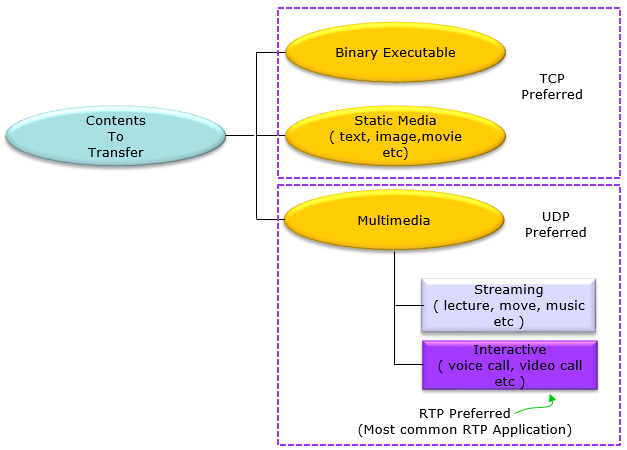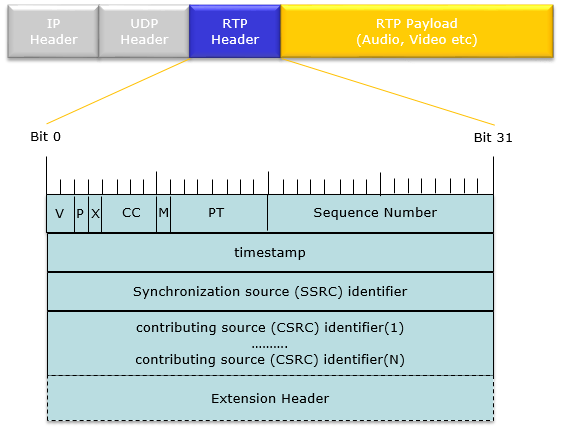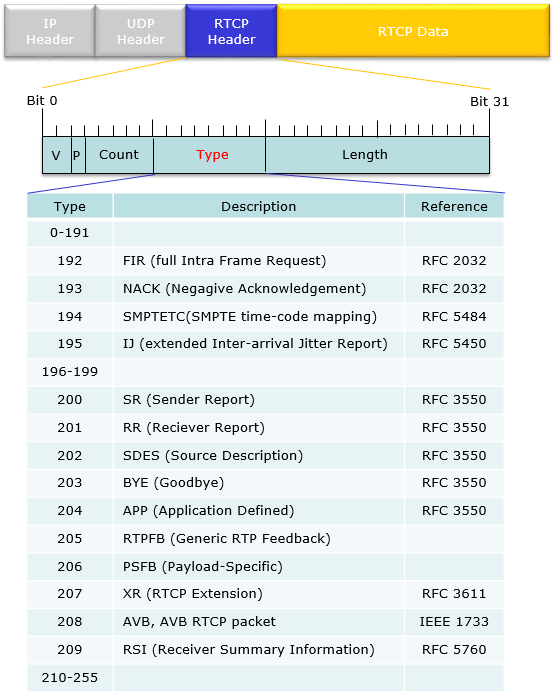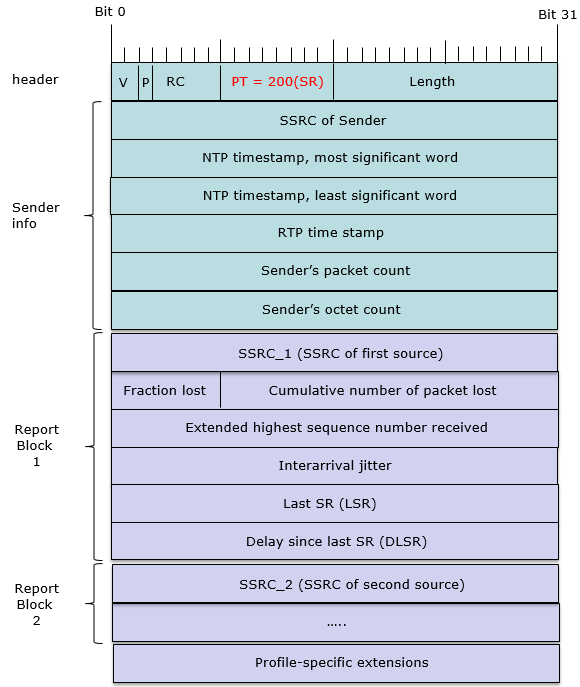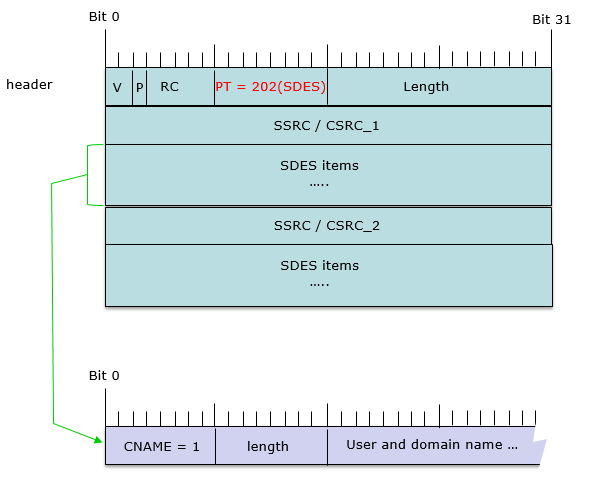|
IMS |
||
|
RTP/RTCP
RTP stands for Real Time Protocol and RTCP stands for Real Time Control Protocol. Simply put, RTP is a protocol to carry various real time data (e.g, audio, video) and RTCP is a kind of control mechanism for RTP.
Basic Functionalities of RTP and RTCP
Some of the import functions of RTP and RTCP are listed below. I think the best way to get the detailed understanding of RTP and RTCP is to go through header structure of these protocol and see what kind of parameter (information) are included in the header and understand the role (meaning) of each of the parameters.
Intreplay between RTP and RTCP
In most of SIP based traffic, RTP and RTCP interplays each other. RTP is responsible for transmitting the multimedia content, while RTCP is responsible for providing feedback and control information about the RTP stream. Both protocols work together to ensure the delivery of high-quality multimedia content over the internet.
RTP is responsible for transporting the multimedia data, such as audio and video, from the source to the destination. It works by breaking the data into small packets and sending them over the network. RTP does not provide any error correction or flow control, but it does provide timestamping and sequencing information that allows the receiving end to reconstruct the original data stream.
On the other hand, RTCP is responsible for providing feedback and control information about the RTP stream. RTCP packets are sent from the receiver back to the sender, containing information such as the number of packets received, the amount of data received, and the quality of service. This information can be used by the sender to adjust the transmission rate and quality of the stream.
Intreplay between SIP and RTP/RTCP
In short, SIP is used to establish and manage multimedia sessions in IP-based networks, while RTP and RTCP are used to transport the actual multimedia content between the endpoints. The SIP protocol is used to negotiate the parameters for the RTP and RTCP streams, and may also contain information about the IP addresses and port numbers to be used for the RTP and RTCP connections.
When a SIP session is established, the SIP protocol is used to negotiate the parameters for the multimedia exchange, such as the codecs to be used, the transport protocol (UDP or TCP), and the port numbers for the RTP and RTCP streams. Once the parameters are negotiated, the endpoints can begin transmitting RTP and RTCP packets over the network to transport the actual multimedia content.
For example, in a typical voice or video call using SIP, the endpoints first use SIP to establish the call and negotiate the parameters for the RTP and RTCP streams. Once the call is established, the endpoints begin sending RTP and RTCP packets containing the voice or video data.
During the call, the RTP and RTCP packets are sent independently of the SIP signaling messages, and are typically transported over separate UDP or TCP connections. However, the SIP signaling messages may contain information about the RTP and RTCP streams, such as the IP addresses and port numbers to be used, in order to facilitate the setup of the RTP and RTCP connections.
Following is a general procedure for voice call over SIP showing the interplay of SIP, RTP, RTCP. (NOTE : This is just an overal flow. There can be variation in term of details with each implementation. Check out this note for a concrete example of voice call over IMS/SIP in LTE). 1) The user initiates a voice call from their SIP client, sending a SIP INVITE message to the recipient's SIP client. The INVITE message includes the details of the call, such as the SIP addresses of the caller and recipient, the media type (audio), and the preferred codec. 2) The recipient's SIP client receives the INVITE message and sends a SIP 200 OK response message to the caller's SIP client, indicating that the call has been accepted. The 200 OK message also includes the IP address and port number for the RTP and RTCP streams. 3) The caller's SIP client sends an ACK message to the recipient's SIP client, acknowledging the acceptance of the call. 4) The caller's SIP client initiates the RTP stream by sending the first RTP packet containing the voice data to the recipient's IP address and port number. The RTP packet contains a sequence number and timestamp. 5) The recipient's SIP client receives the RTP packet and sends an RTCP receiver report message back to the caller's SIP client. The receiver report includes information about the quality of the received voice data, such as the number of packets lost or received. 6) The caller's SIP client receives the RTCP receiver report and adjusts the transmission rate of the voice data if necessary. 7) The caller's SIP client continues to send RTP packets containing the voice data to the recipient's IP address and port number. The recipient's SIP client continues to send RTCP messages back to the caller's SIP client to provide feedback on the received voice data. 8) At the end of the call, either the caller or the recipient sends a SIP BYE message to terminate the call. The BYE message is acknowledged with a SIP 200 OK message. 9) The RTP and RTCP streams are closed, and the call is terminated.
How can we figure out the type of transport for RTP ?
How can I know whether TCP or UDP is used for a specific RTP session ?
The decision to use either TCP or UDP for the RTP transport protocol is typically made during the initial SDP negotiation between the endpoints in the SIP INVITE message. The SDP message contains a media-level attribute called "proto", which indicates the transport protocol to be used for the associated media stream.
If the "proto" attribute is set to "RTP/AVP", it indicates that the RTP and RTCP streams will use UDP as the transport protocol. If the "proto" attribute is set to "RTP/AVP/TCP", it indicates that the RTP and RTCP streams will use TCP as the transport protocol.
Here is an example of an SDP message that indicates the use of UDP for RTP: v=0 o=user1 1234 5678 IN IP4 192.0.2.1 s=Session SDP c=IN IP4 192.0.2.1 t=0 0 m=audio 49170 RTP/AVP 0 // here there is no keyword TCP implying that it is UDP with port number 49170 a=rtpmap:0 PCMU/8000 a=sendrecv
Here is an example of an SDP message that indicates the use of TCP for RTP: v=0 o=user1 1234 5678 IN IP4 192.0.2.1 s=Session SDP c=IN IP4 192.0.2.1 t=0 0 m=audio 49170 RTP/AVP/TCP 0 // here there is the keyword TCP implying that it is TCP with port number 49170 a=rtpmap:0 PCMU/8000 a=sendrecv
Following diagram shows the structure of a RTP header in UDP. But the same structure can be embedded into TCP payload as well.
< RFC 3551 : Table 4: Payload types (PT) for audio encodings >
PT encoding media type clock rate channels name (Hz) ___________________________________________________ 0 PCMU A 8,000 1 1 reserved A 2 reserved A 3 GSM A 8,000 1 4 G723 A 8,000 1 5 DVI4 A 8,000 1 6 DVI4 A 16,000 1 7 LPC A 8,000 1 8 PCMA A 8,000 1 9 G722 A 8,000 1 10 L16 A 44,100 2 11 L16 A 44,100 1 12 QCELP A 8,000 1 13 CN A 8,000 1 14 MPA A 90,000 (see text) 15 G728 A 8,000 1 16 DVI4 A 11,025 1 17 DVI4 A 22,050 1 18 G729 A 8,000 1 19 reserved A 20 unassigned A 21 unassigned A 22 unassigned A 23 unassigned A dyn G726-40 A 8,000 1 dyn G726-32 A 8,000 1 dyn G726-24 A 8,000 1 dyn G726-16 A 8,000 1 dyn G729D A 8,000 1 dyn G729E A 8,000 1 dyn GSM-EFR A 8,000 1 dyn L8 A var. var. dyn RED A (see text) dyn VDVI A var. 1
< RFC 3551 : Table 5: Payload types (PT) for video and combined encodings >
PT encoding media type clock rate name (Hz) _____________________________________________ 24 unassigned V 25 CelB V 90,000 26 JPEG V 90,000 27 unassigned V 28 nv V 90,000 29 unassigned V 30 unassigned V 31 H261 V 90,000 32 MPV V 90,000 33 MP2T AV 90,000 34 H263 V 90,000 35-71 unassigned ? 72-76 reserved N/A N/A 77-95 unassigned ? 96-127 dynamic ? dyn H263-1998 V 90,000
Example 01 > Real-Time Transport Protocol [Stream setup by SDP (frame 9)] [Setup frame: 9] [Setup Method: SDP] 10.. .... = Version: RFC 1889 Version (2) ..0. .... = Padding: False ...0 .... = Extension: False .... 0000 = Contributing source identifiers count: 0 1... .... = Marker: True Payload type: DynamicRTP-Type-97 (97) Sequence number: 21770 [Extended sequence number: 87306] Timestamp: 483390931 Synchronization Source identifier: 0x113db031 (289255473) Payload: f03c70696cc8e17b8588e8e60ff623270580007e56418a28...
The RTCP packet structure provides a mechanism for monitoring the quality of multimedia streams in real-time, enabling applications to adjust their behavior in response to changes in the network conditions.
The structure of the RTCP packet may vary depending on the type of packet being sent. For example, RTCP Sender Report (SR) packets contain additional information, such as the timestamp of the last packet sent by the source, the number of packets sent, and the number of bytes sent. RTCP Receiver Report (RR) packets contain information about the quality of the received packets, such as the number of packets lost and the interarrival time between packets.
Following diagram shows the structure of a RTCP header in UDP. But the same structure can be embedded into TCP payload as well.
RTCP SR (Sender Report) is a type of RTCP packet that is sent by the sender of an RTP stream to report on the characteristics of the stream. The RTCP SR packet is sent periodically by the sender of the RTP stream to provide information about the characteristics of the stream and to enable the other participants in the session to adjust their reception parameters accordingly
Followings are brief descriptions for each of the field :
The reception report blocks (RR blocks) contain information about the quality of service of the RTP stream as received by the other participants in the session. The reception report blocks provide feedback on the quality of service of the stream as experienced by the other participants, allowing the sender to adjust its transmission parameters to improve the quality of the stream.
Followings are the field description of RR packet.
RTCP - SDES (Source Description)
SDES (Source Description) is a type of RTCP packet that is used to provide additional information about the participants in a session. It is typically sent periodically by each participant in a session to provide additional information about themselves and to enable the other participants to identify them. The information provided can be used, for example, to display the names of the participants in a video conference or to help diagnose network problems by providing information about the tools being used by the participants. The SDES items are optional and can be included or excluded as needed, depending on the requirements of the application.
The RTCP SDES packet contains the following fields:
Each SDES item consists of a type field and a value field. The type field specifies the type of information being provided, while the value field contains the actual information. The following are some of the most commonly used SDES item types:
Example 01 > Real-time Transport Control Protocol (Sender Report) [Stream setup by SDP (frame 2)] [Setup frame: 2] [Setup Method: SDP] 10.. .... = Version: RFC 1889 Version (2) ..0. .... = Padding: False ...0 0001 = Reception report count: 1 Packet type: Sender Report (200) Length: 12 (52 bytes) Sender SSRC: 0x113db030 (289255472) Timestamp, MSW: 300 (0x0000012c) Timestamp, LSW: 1786706395 (0x6a7ef9db) [MSW and LSW as NTP timestamp: Feb 7, 2036 06:33:16.415999999 UTC] RTP timestamp: 483391347 Sender's packet count: 4 Sender's octet count: 132 Source 1 Identifier: 0x113db031 (289255473) SSRC contents Fraction lost: 0 / 256 Cumulative number of packets lost: 1 Extended highest sequence number received: 0 Sequence number cycles count: 0 Highest sequence number received: 0 Interarrival jitter: 0 Last SR timestamp: 0 (0x00000000) Delay since last SR timestamp: 0 (0 milliseconds) Real-time Transport Control Protocol (Source description) [Stream setup by SDP (frame 2)] [Setup frame: 2] [Setup Method: SDP] 10.. .... = Version: RFC 1889 Version (2) ..0. .... = Padding: False ...0 0001 = Source count: 1 Packet type: Source description (202) Length: 4 (20 bytes) Chunk 1, SSRC/CSRC 0x113DB030 Identifier: 0x113db030 (289255472) SDES items Type: CNAME (user and domain) (1) Length: 7 Text: unknown Type: END (0) [RTCP frame length check: OK - 72 bytes]
Example 02 > Real-time Transport Control Protocol (Sender Report) [Stream setup by SDP (frame 112)] [Setup frame: 112] [Setup Method: SDP] 10.. .... = Version: RFC 1889 Version (2) ..0. .... = Padding: False ...0 0001 = Reception report count: 1 Packet type: Sender Report (200) Length: 12 (52 bytes) Sender SSRC: 0x3f8ead04 (1066315012) Timestamp, MSW: 3721497922 (0xddd18d42) Timestamp, LSW: 1046146659 (0x3e5aee63) [MSW and LSW as NTP timestamp: Dec 5, 2017 21:25:22.243574999 UTC] RTP timestamp: 1313316619 Sender's packet count: 72 Sender's octet count: 60905 Source 1 Identifier: 0x3f8ead03 (1066315011) SSRC contents Fraction lost: 0 / 256 Cumulative number of packets lost: 0 Extended highest sequence number received: 6346 Sequence number cycles count: 0 Highest sequence number received: 6346 Interarrival jitter: 2363 Last SR timestamp: 2369797437 (0x8d403d3d) Delay since last SR timestamp: 130277 (1987 milliseconds)
Example 03 > Real-time Transport Control Protocol (Sender Report) [Stream setup by SDP (frame 125)] [Setup frame: 125] [Setup Method: SDP] 10.. .... = Version: RFC 1889 Version (2) ..0. .... = Padding: False ...0 0001 = Reception report count: 1 Packet type: Sender Report (200) Length: 12 (52 bytes) Sender SSRC: 0x00819e3b (8494651) Timestamp, MSW: 8496 (0x00002130) Timestamp, LSW: 2924872728 (0xae560418) [MSW and LSW as NTP timestamp: Feb 7, 2036 08:49:52.680999999 UTC] RTP timestamp: 32000 Sender's packet count: 53 Sender's octet count: 2223 Source 1 Identifier: 0x00819e3c (8494652) SSRC contents Fraction lost: 4 / 256 Cumulative number of packets lost: 1 Extended highest sequence number received: 52 Sequence number cycles count: 0 Highest sequence number received: 52 Interarrival jitter: 3 Last SR timestamp: 0 (0x00000000) Delay since last SR timestamp: 0 (0 milliseconds) Real-time Transport Control Protocol (Source description) [Stream setup by SDP (frame 125)] [Setup frame: 125] [Setup Method: SDP] 10.. .... = Version: RFC 1889 Version (2) ..0. .... = Padding: False ...0 0001 = Source count: 1 Packet type: Source description (202) Length: 6 (28 bytes) Chunk 1, SSRC/CSRC 0x819E3B Identifier: 0x00819e3b (8494651) SDES items Type: CNAME (user and domain) (1) Length: 14 Text: 2001:0:0:1::11 Type: END (0)
Example 04 > Real-time Transport Control Protocol (Goodbye) [Stream setup by SDP (frame 125)] [Setup frame: 125] [Setup Method: SDP] 10.. .... = Version: RFC 1889 Version (2) ..0. .... = Padding: False ...0 0001 = Source count: 1 Packet type: Goodbye (203) Length: 2 (12 bytes) Identifier: 0x3f8ead03 (1066315011) Length: 0 Text:
Example 05 > Real-time Transport Control Protocol (Sender Report) [Stream setup by SDP (frame 125)] [Setup frame: 125] [Setup Method: SDP] 10.. .... = Version: RFC 1889 Version (2) ..0. .... = Padding: False ...0 0001 = Reception report count: 1 Packet type: Sender Report (200) Length: 12 (52 bytes) Sender SSRC: 0x00819e3b (8494651) Timestamp, MSW: 8530 (0x00002152) Timestamp, LSW: 2744484102 (0xa3958106) [MSW and LSW as NTP timestamp: Feb 7, 2036 08:50:26.638999999 UTC] RTP timestamp: 575328 Sender's packet count: 789 Sender's octet count: 30996 Source 1 Identifier: 0x00819e3c (8494652) SSRC contents Fraction lost: 0 / 256 Cumulative number of packets lost: 1 Extended highest sequence number received: 788 Sequence number cycles count: 0 Highest sequence number received: 788 Interarrival jitter: 3 Last SR timestamp: 558933082 (0x2150a45a) Delay since last SR timestamp: 129369 (1974 milliseconds) Real-time Transport Control Protocol (Source description) [Stream setup by SDP (frame 125)] [Setup frame: 125] [Setup Method: SDP] 10.. .... = Version: RFC 1889 Version (2) ..0. .... = Padding: False ...0 0001 = Source count: 1 Packet type: Source description (202) Length: 6 (28 bytes) Chunk 1, SSRC/CSRC 0x819E3B Identifier: 0x00819e3b (8494651) SDES items Type: CNAME (user and domain) (1) Length: 14 Text: 2001:0:0:1::11 Type: END (0) Real-time Transport Control Protocol (Goodbye) [Stream setup by SDP (frame 125)] [Setup frame: 125] [Setup Method: SDP] 10.. .... = Version: RFC 1889 Version (2) ..0. .... = Padding: False ...0 0001 = Source count: 1 Packet type: Goodbye (203) Length: 7 (32 bytes) Identifier: 0x00819e3b (8494651) Length: 22 Text: Disconnect IMS Session
Reference :
[1] RTP: Multimedia Streaming over IP [2] RTP, RTCP and RTSP - Internet Protocols for Real-Time Multimedia Communication [3] 6.3.1 SR: Sender report RTCP packet
|
||
